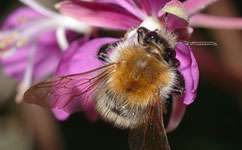Citizen scientists help reveal bumblebee decline

The great British public has helped scientists uncover what looks like a substantial decline in one of the UK's most common bumblebees over the last 20 years.
By gathering valuable information about the insects, citizen scientists from across Britain have shown that the common carder-bee made up less than 10 per cent of bumblebee colonies from 2007 to 2009.
Just 20 years previously, they made up a whopping 21 per cent.
This is the first time anyone has shown that one of the UK's big six common bumblebees may be in decline. Information uncovered in the study will help researchers boost nesting sites for bees.
The survey also revealed that one bumblebee species, which isn't native to the UK, has made its way across the channel – probably from France – and is now found in lots of gardens. The tree bumblebee occurs naturally in France, only arriving in the UK in 2001.
"There seems to be a clear shift in how common different species in the UK are," says Dr. Gillian Lye from the University of Stirling, lead author of the study, published in the Journal of Insect Conservation.
Other studies have shown declines in UK bumblebee species. Scientists think this is down to habitat loss and changes in farming practices, which has reduced the numbers of plants the insects forage on. But scientists need to know exactly where the bees make their nests before making suggestions on what habitat is important.
Professor Dave Goulson from the University of Stirling and Lye came up with the idea of getting enthusiastic members of the public to help them get to grips with bumblebee nesting ecology when they realised they could get a lot more information than they could on their own.
"Bumblebee nests are hard to find, so it can be a time-consuming activity. You can spend all day looking and even then you might only find one nest," says Goulson.
"But we need this information, because some species could be limited by nest sites. Not just that, but it's a great way to get people interested in wildlife. Once they're engaged, they tend to stick with it year after year," he adds.
More and more people are helping collect data to contribute to important scientific studies. The British Trust for Ornithology has a long tradition of using amateurs to collect information on birds, and the search for extraterrestrial intelligence (SETI) relies on people's idle home computers.
The data these citizen scientists collect is essential. It would be impossible to set up an army of professional scientists to survey Britain's natural history at the same scale as is possible with members of the public.
"People tend to spend quite a lot of time in their gardens, so spotting bumblebees and following them to their nests is a real possibility," says Goulson.
In this latest study, Goulson, Lye and colleagues asked members of the public to send information about which species they saw and what type of nest the bees used to the Bumblebee Conservation Trust. They encouraged people to send photographs, so that Lye could confirm the species.
In total, over a thousand people sent information about the nests in their gardens.
As well as finding a shift in different species' abundances, the information collected by survey participants exploded the myth that bumblebees tend to nest in the same spot year after year. Just nine per cent of sites were re-used by bees the following year.
One of the reasons for the decline in the common carder-bee could be that its favourite flowers are disappearing. The long-tongued bees favour plants like clover, trefoils and vetches, all of which are legumes.
"These plants have their own personal supply of nitrogen, so they thrive in places where nutrients are low," explains Goulson.
Farmers used to rely on legumes to improve the soil, but a surge in the use of fertilizers has sent them into steep decline.
"The common carder-bee fertilizes broad beans, so if this is a real decline, this could become an issue," Goulson says.
But it's not all bad news. You can do your bit by growing plants that flower throughout the year in your garden. This gives the bees something to forage on. Your garden can also provide them with nesting habitat.
This story is republished courtesy of Planet Earth online, a free, companion website to the award-winning magazine Planet Earth published and funded by the Natural Environment Research Council (NERC).
More information: Gillian C. Lye, et al., Using citizen science to monitor Bombus populations in the UK: nesting ecology and relative abundance in the urban environment, Journal of Insect Conservation, published online 23 November 2011, DOI:10.1007/s10841-011-9450-3
Provided by PlanetEarth Online



















